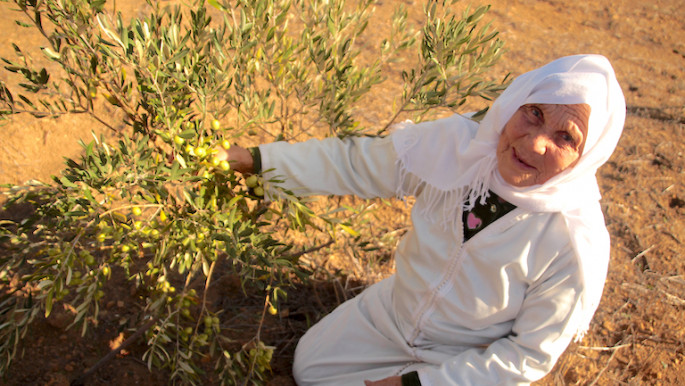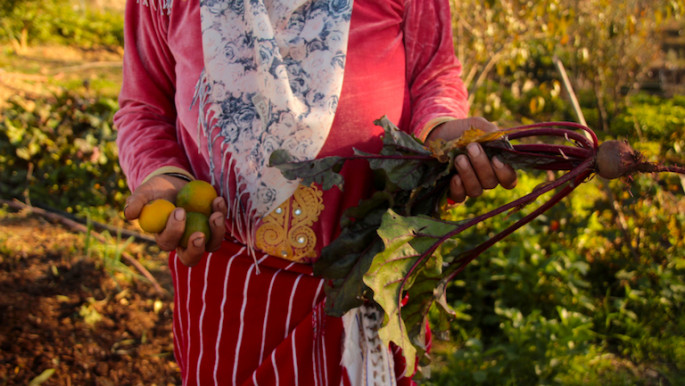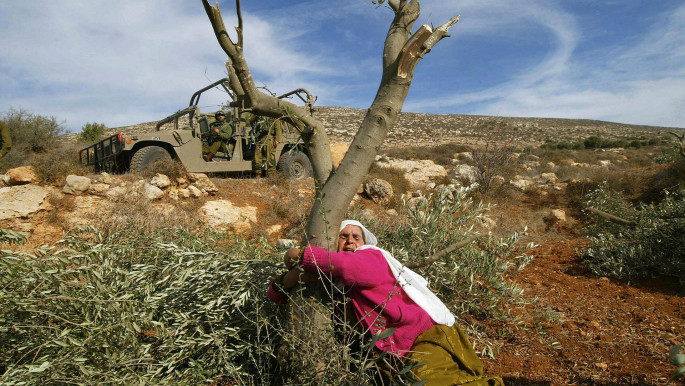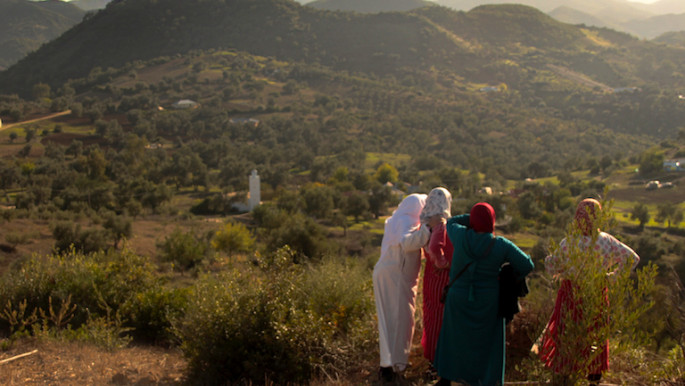Agroforestry empowers Morocco's mountain women
In the Rif, Morocco's northernmost mountains, the climate is more unstable than ever. Rheia, 85, couldn't believe that the fruits weren't yet ripe.
"I never saw anything like this in my life. Also, last summer we did not collect any figs," she says. "At this time of the year we usually have already finished the olive harvest."
The end of the olive-picking season should have been November 20, coinciding with the birthday of the Prophet Muhammad. Rheia's family should also have had fresh-pressed oil on their table, especially for tagine, the popular dish named after the earthenware pot in which it's slow-cooked.
But during the summer of 2018, temperatures hit 44 degrees Celsius (111 degrees Fahrenheit), hot enough to burn fig flowers. Then during the autumn, rains were so heavy that the olives hadn't ripened.
Rheia and 328 other women are part of Femmes du Rif, a local "group of economic interest", or GEO, supervised by the United Nations Industrial Development Organization (ONUDI). It's a project that brings together 10 all-women cooperatives practicing agroforestry and producing olive oil in the Rif Mountains.
Most are scattered in remote villages surrounding Ouezzane, a city well-known for the religious practice of Sufism.
 |
|
| Suisi Rheia, 85, checking olives for ripeness [Monica Pelliccia] |
Olives versus climate change
The members of Femmes du Rif grow olive trees (Olea europaea) with figs (Ficus carica), carobs (Ceratonia siliqua) and annual crops planted in rotation, including chickpeas, fava beans, wheat, and livestock forage.
These Jebala ("mountain") people have long practiced this traditional agroforestry system, where the annual crops are grown in close association to help them thrive and survive drought - and the trees are old, too.
"Most of the olive trees have been planted in a scattered way by my ancestors," says Rheia. "They are more than 200 years old."
 |
Most of the olive trees have been planted in a scattered way by my ancestors... They are more than 200 years old |  |
The Jebala people's economy has been linked to olive trees since ancient times, but climate instability looks likely to disrupt this tradition.
The United States Agency for International Development (USAID) estimates an increase in the average temperature in Morocco of 1 to 1.5 degrees Celsius (1.8 to 2.7 degrees Fahrenheit) by 2050, and a consequent 50 to 75 percent reduction in yields of rain-fed annual crops during dry years.
A recent World Meteorological Organization report noted that 2017 saw a new global record of greenhouse gas levels in the atmosphere, which is driving long-term climate change, sea level rise, ocean acidification, and more extreme weather events.
 |
|
| Fatima Stitou shows other products of her agroforestry system; beets and citrus [Monica Pelliccia] |
Agroforestry can offer an alternative, though, thanks to trees. This practice of cultivating trees like olives with annual crops reduces soil erosion and water loss. It's already well-established in oases and mountainous regions of Morocco, where arable land and water resources are scarce, according to a study by AGFORWARD (AGroFORestry that Will Advance Rural Development), a four-year research project funded by the European Union.
The Moroccan government plans to increase support for agroforestry systems that plant climate change-resistant trees, such olive and fig, rather than less-resilient species like orange, lime and plum. Plan Maroc Vert (PMV) is a government programme that also aided the creation of Femmes du Rif.
"Planting of olives and figs is a way to counteract climate change, desertification, and reduce soil erosion," explains Otman El Mrabet, the provincial director of agriculture in Ouezzane.
"We support the work of rural women in order to produce IGP [Protected Geographical Indication] olive oil, an excellent product. Jebala people have an ancient reputation as olive growers."
 |
Planting of olives and figs is a way to counteract climate change, desertification, and reduce soil erosion |  |
From mountains to market
Pur Projet, a French social enterprise, has also been funding Femmes du Rif's tree planting since 2011.
"Olive trees are perennial plants, resistant to several climatic conditions [that] guarantee constant incomes through olive oil commercialisation with Femmes du Rif GEO," says Anaïs Gentit, coordinator of Pur Projet's agroforestry-based projects in Africa.
"Olive trees are grown in the same parcel as annual legumes that enrich the soil with nitrogen. Also, figs, carobs and legumes offer an extra income to the farmers, [who] can sell the surplus to the souk," she adds.
 |
|
| Read also: How Israel is uprooting West Bank's future |
Rabia Hakouch, 56, lives in the most fertile area of Asjen village, which is also home to hares, boars and partridges. In her garden, she grows tomatoes and beets, legumes, fruits such as oranges, and also oats to feed her goats, cows and chickens.
She also grows medicinal plants like chamomile, thyme, mint and verbena for use in producing essential oils that treat rheumatism, headaches, and skin and mouth ailments.
Hakouch is a widow and dresses in a long, black djellaba, the typical Moroccan tunic. She managed to pay for the education of seven sons and a daughter thanks to sales of her olive oil and also the fruits, vegetables, legumes and essential oils. In the past, many children had to help their mothers in the fields instead of going to school.
 |
She managed to pay for the education of seven sons and a daughter thanks to sales of her olive oil and also the fruits, vegetables, legumes and essential oils |  |
But now, thanks to revenue earned from being members of the cooperative, many women's main goal of paying for their children's education is being realised.
"I achieved [sending] my daughter to the university," Hakouch says proudly. "Now, she is the dentist of our community."
Collective power
Femmes du Rif's olive oil has helped ensure these revenues. The IGP designation, which certifies that the oil is produced only in this region, allows the women to sell their olive oil at the higher price of 43 dirhams ($4.50) per litre instead of the typical market price of 30 dirhams ($3.20).
IGP designation means the oil can reach different clients, such as hotels. They also avoid the expenses of travel to the market in the city, more than an hour's drive from their villages.
Fatima Stitou, 60, recently managed to renovate her house. She lives in Aïm Beïda village and is Rheia's neighbour. As in most cases here, their farm plots are located on a slope, on which they grow olive, carob and fig trees.
From the peak, there's a panoramic view of the valley and the surrounding mountaintops, almost entirely covered with olive trees. On the horizon, a neighbour is returning home on the back of a donkey, a veil around her face protecting her from the dust.
Upon returning to the village, the women have mint tea on Stitou's patio. They eat khobz, the typical round loaf cooked in a wood oven, accompanied by green and black olives and seasoned with garlic.
Everything here comes from their gardens, including the basic ingredients of a favourite recipe of the Jebala people, bessara, a fava bean soup seasoned with plenty of olive oil, cumin and paprika. Olive oil is a central ingredient in Moroccan cuisine, as in the wider Mediterranean.
 |
For each woman, we estimate an annual benefit of $6,850, approximately. Those revenues give an economic stability to their families and communities |  |
"For each woman, we estimate an annual benefit of $6,850, approximately. Those revenues give an economic stability to their families and communities," says Hanane Lachehab, 38, president of Femmes du Rif.
She says the funds to build much of the community infrastructure, including the road to Nefzi, the most remote village in the cooperative, some 60 kilometres (40 miles) from Ouezzane, comes from these earnings.
This allows the villages to "avoid the depopulation process that we experienced in the past", Lachehab says, and gives a "chance for the young generation to remain here [instead of] migrating to big cities such as Fez or Tangier."
And perhaps most importantly, the members' new economic stability has helped them abandon the growing of cannabis. The crop is illegal, though grown mostly in Larache province, close to Fez and the Rif Mountains, especially in the areas surrounding Chefchaouen.
 |
|
| Members of the Femmes Du Rif stand atop Fatima Stitou's parcel surrounded by lands growing olive, fig, and carob [Monica Pelliccia] |
To the Moroccan parliament
For Hanane Lachehab, Femmes du Rif is much more than agroforestry and production of IGP olive oil. It's the reason that gets the women out of their houses and provides well-deserved recognition for their work, which normally goes unacknowledged.
There's also been progress on their social rights: their roles within the cooperative are specified in their documents and certified by municipal employees. This allow them to vote for the political representative to the regional chamber of agriculture, and to be elected themselves.
Lachehab studied management at university and then decided to return to her village and find a way to create job opportunities for her neighbours. Now she's a political representative for the North Regional Committee, elected thanks to her work with Femmes du Rif (for which she also won a Terres du Femmes Prize in 2017).
 |
There's also been progress on their social rights: their roles within the cooperative are specified in their documents and certified by municipal employees |  |
She also proudly shares the story of her neighbour, Fatima Habboussi: In 2015, the Femmes du Rif member became the first woman elected to the Moroccan parliament, after serving on the Regional Chamber of Agriculture committee.
"Jebala women always worked in the olive oil fields," Lachehab says. "Thanks to the cooperatives, women are more and more exposed to public life. They exist also outside of their villages and families. Most of them just traveled for the first time away from their villages to participate in meetings both in Morocco and in foreign countries," she adds, referring to a recent trip to Spain to promote the group's olive oil.
Ongoing delay
But Lachehab, like Suisi Rheia, has never experienced such a seasonal delay in olive harvesting during her 18 years in the business, as they're seeing now.
Checking the weather forecast on her phone, she notes that more rain is expected the following week; the olives will need at least one sunny week to ripen on the trees.
Though harvest time had not fully arrived yet for the Femmes du Rif members (and was still not complete at the time of this writing), they now have the luxury of waiting, thanks to greater incomes and financial resiliency provided by their cooperative and the sustainable agroforestry farming system that supplies its olive oil.
Monica Pelliccia is an independent multimedia journalist. Follow her on Twitter: @monicapelliccia




 Follow the Middle East's top stories in English at The New Arab on Google News
Follow the Middle East's top stories in English at The New Arab on Google News


